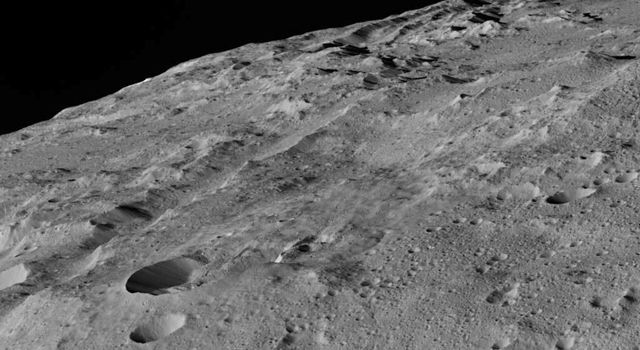
NASA has released the first images of the dwarf planet Ceres from the Dawn spacecraft’s new lowest orbit. This is the closest view that Dawn will have of Ceres and its intriguing white spots, providing an unprecedented look at this small but fascinating world.
The new images were taken Dec. 10 in the low-altitude mapping orbit (LAMO), from an altitude of only 240 miles (385 kilometers), and have a resolution of 120 feet (35 meters) per pixel. Dawn will remain at this altitude for the rest of its mission. Ceres can now be photographed with the most detail yet seen, including, of course, the famous white spots, which researchers now think are most likely salt deposits left on the surface after water or ice evaporated.
These first images were taken as part of a test of Dawn’s backup framing camera. The primary framing camera, identical to the backup one, started taking images on Dec. 16.
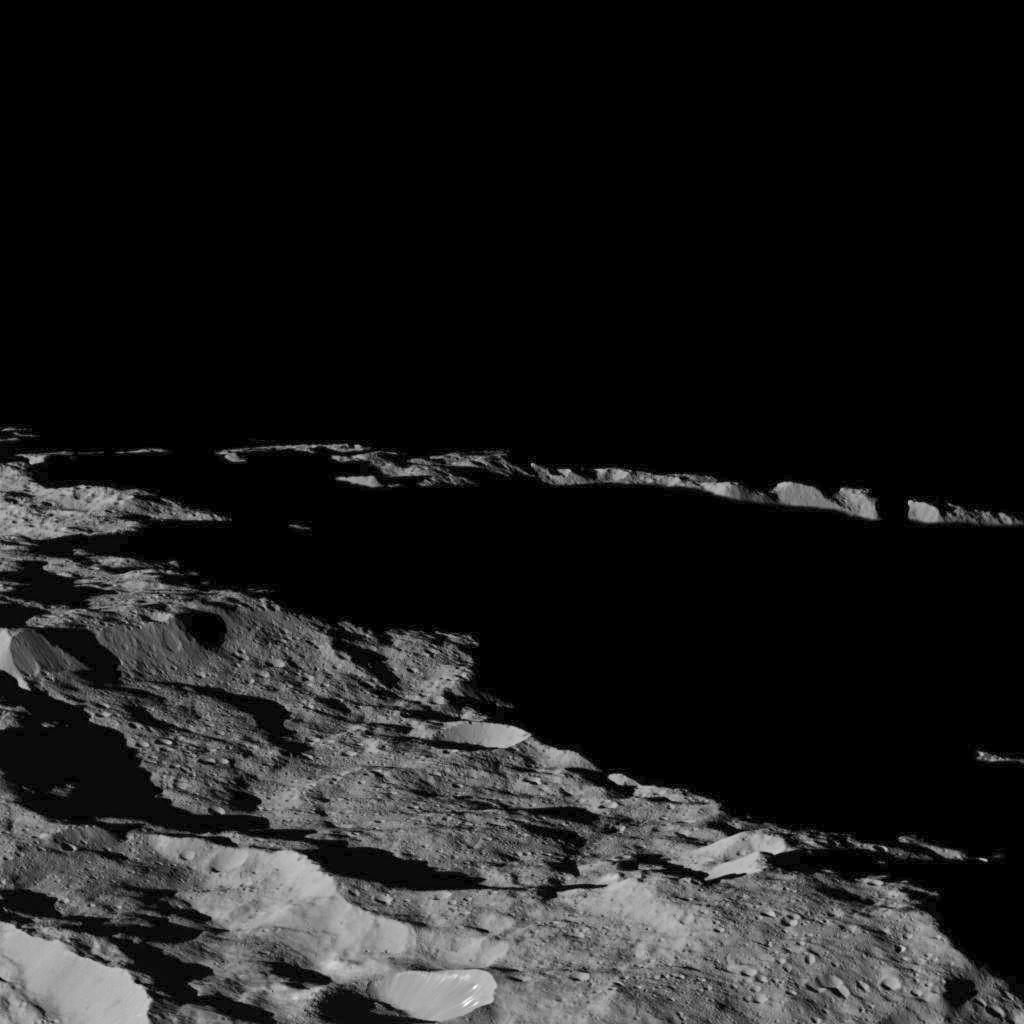
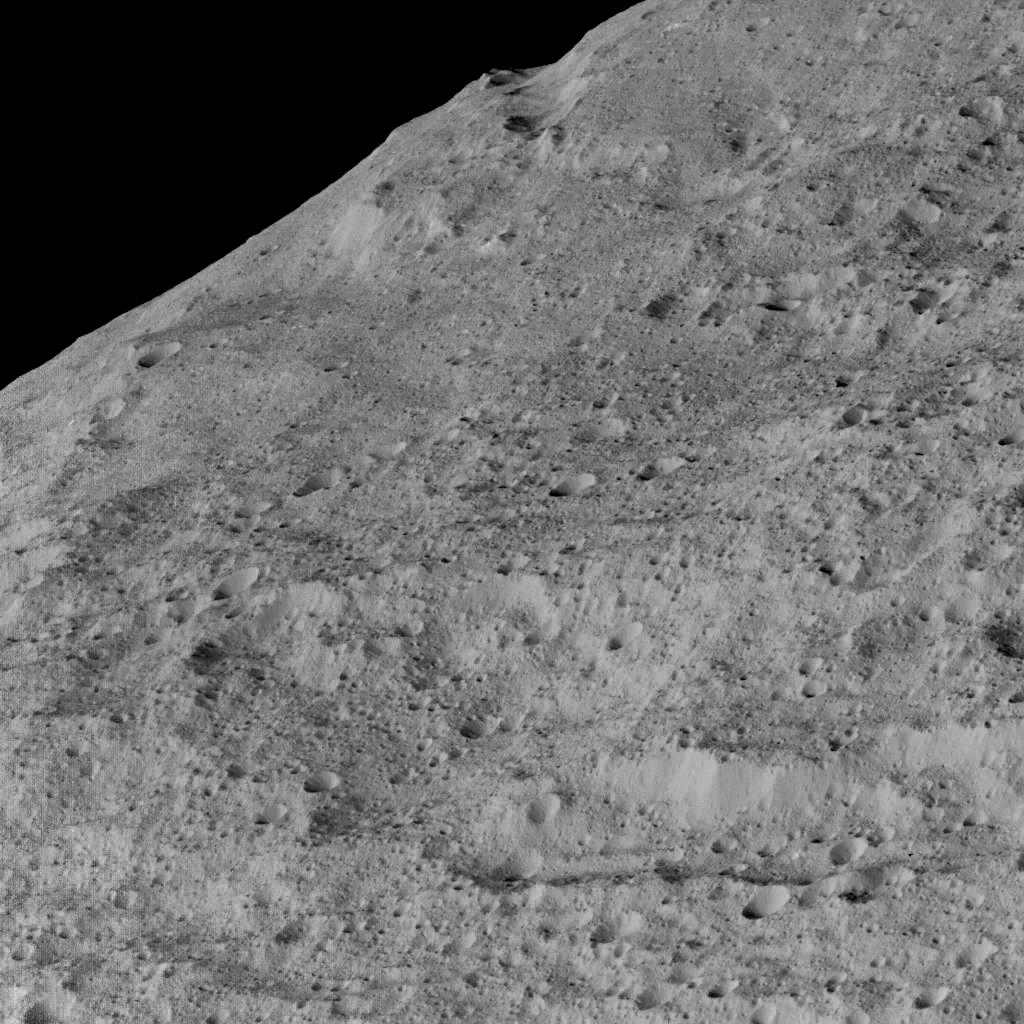
In one of the new views is a crater chain called Gerber Catena, just west of the large crater Urvara. Such crater chains are common on rocky planets and moons which are still covered in many craters. Ceres also has large troughs, which are also common. They are caused by contraction, impact stresses, and the loading of the crust by large mountains. Fracturing has occurred on Ceres as well, despite its small size, only 584 miles (940 kilometers) in diameter on average. Some of Ceres’ troughs may even be tectonic in origin, according to researchers.
“Ceres is so big compared to all the other asteroids that it’s really different,” said Andrew Rivkin, a planetary scientist at the Johns Hopkins University Applied Physics Laboratory in Laurel, Md. “It’s sort of the penultimate step before a planet.”
“Why they are so prominent is not yet understood, but they are probably related to the complex crustal structure of Ceres,” said Paul Schenk, a Dawn science team member at the Lunar and Planetary Institute, Houston.
As well as images, Dawn will be using all of its instruments to study Ceres from its new vantage point. These include the visible and infrared mapping spectrometer and the gamma ray and neutron detector. Dawn will examine minerals on Ceres’ surface, as well as measure the energies and numbers of gamma rays and neutrons.
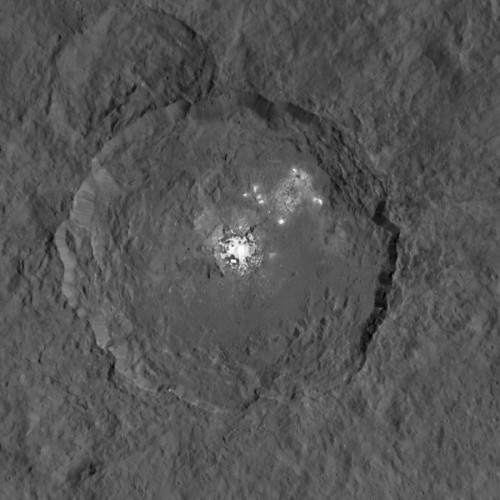
Ceres has surprised scientists so far, with its odd spots and apparent ammoniated clays on its surface. Measurements of the brightest spots in Occator crater suggest the presence of a type of magnesium sulfate called hexahydrite. Evaporation of water or ice seems to be involved, but whether the spots formed after impacts or perhaps hydrothermal activity isn’t clear yet. Haze has been observed inside Occator crater, but only around noon time on Ceres, not at dawn or dusk. It is theorized that the process may be similar to what happens on comets, when water vapor lifts tiny particles of dust and ice off the surface.
“As we take the highest-resolution data ever from Ceres, we will continue to examine our hypotheses and uncover even more surprises about this mysterious world,” said Chris Russell, principal investigator of the Dawn mission, based at the University of California, Los Angeles.
As reported previously on AmericaSpace, two new studies now suggest that the bright spots are salt deposits, not ice, as had been previously theorized, and that there are ammonia-rich clays on Ceres—another unexpected finding. The spots also suggest that Ceres has a subsurface layer of briny ice.
“The global nature of Ceres’ bright spots suggests that this world has a subsurface layer that contains briny water-ice,” said Andreas Nathues at the Max Planck Institute for Solar System Research in Göttingen, Germany. He notes, “The whole picture we do not have yet.”
Over 130 such spots have been seen by Dawn, most of them being inside impact craters. From the new paper:
“These unusual areas are consistent with hydrated magnesium sulfates mixed with dark background material, although other compositions are possible. Of particular interest is a bright pit on the floor of crater Occator that exhibits probable sublimation of water ice, producing haze clouds inside the crater that appear and disappear with a diurnal rhythm. Slow-moving condensed-ice or dust particles, may explain this haze. We conclude that Ceres must have accreted material from beyond the ‘snow line’11, which is the distance from the Sun at which water molecules condense.”
According to Chris Russell, principal investigator of the Dawn mission, at the University of California, Los Angeles, “The Dawn science team is still discussing these results and analyzing data to better understand what is happening at Occator.”
He added, as reported in Gizmodo: “We believe this is a huge salt deposit. We know it’s not ice and we’re pretty sure it’s salt, but we don’t know exactly what salt at the present time.”
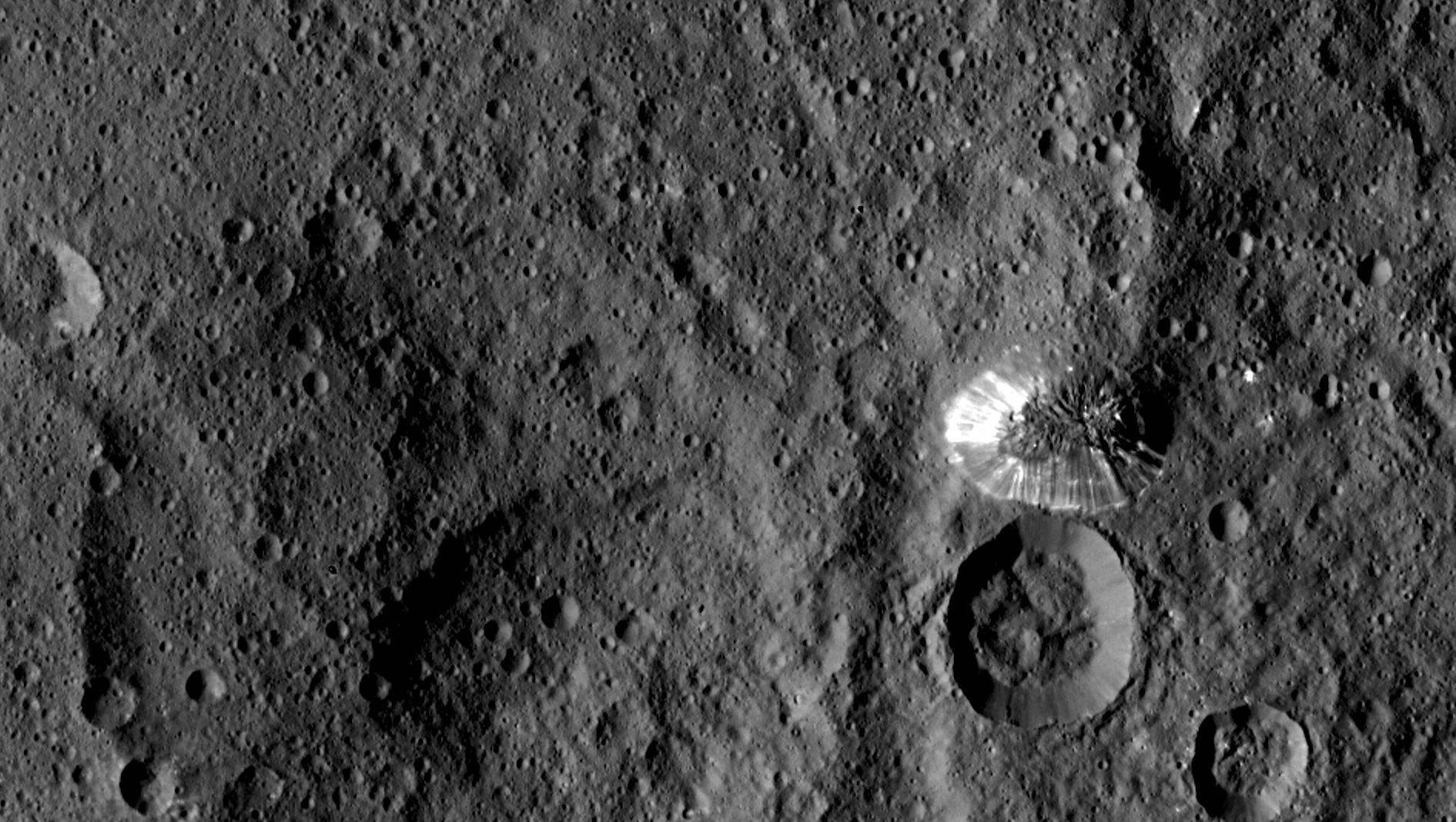
As for the ammonia-rich clay deposits, they provide evidence that Ceres may have originally formed farther out in the Solar System and then migrated inward to where it is now in the main asteroid belt.
According to Maria Cristina De Sanctis, lead author of the new study, at the National Institute of Astrophysics in Rome: “The presence of ammonia-bearing species suggests that Ceres is composed of material accreted in an environment where ammonia and nitrogen were abundant. Consequently, we think that this material originated in the outer cold Solar System.”
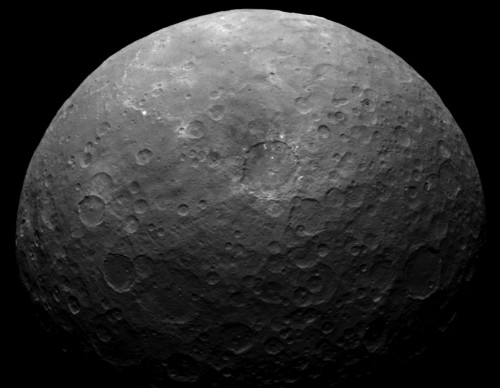
From the new paper:
“Our measurements indicate widespread ammoniated phyllosilicates across the surface, but no detectable water ice. Ammonia, accreted either as organic matter or as ice, may have reacted with phyllosilicates on Ceres during differentiation. This suggests that material from the outer Solar System was incorporated into Ceres, either during its formation at great heliocentric distance or by incorporation of material transported into the main asteroid belt.”
Another intriguing feature is the isolated conical mountain called “The Lonely Mountain,” which is about 4 miles (6 kilometers) tall. How it got there is still a mystery for planetary scientists, but it is additional evidence for active geology on Ceres, at least in the past. With nothing else like it nearby, it stands out like a sore thumb in the surrounding terrain.
As Dawn science team member Paul Schenk, a geologist at the Lunar and Planetary Institute in Houston, Texas, described it: “This mountain is among the tallest features we’ve seen on Ceres to date. It’s unusual that it’s not associated with a crater. Why is it sitting in the middle of nowhere? We don’t know yet, but we may find out with closer observations.”
Ceres is the first dwarf planet to be visited by a spacecraft (Dawn arrived at Ceres on March 6, 2015, well before New Horizons reached Pluto on July 14). Previously, Dawn orbited the protoplanet Vesta in 2011 and 2012. Dawn is also the first spacecraft to visit and orbit two different worlds.
Now that Dawn has settled into its final permanent orbit, scientists will be able to study this small world as never before—an unprecedented opportunity.
More information about the Dawn mission is on the official website.
Please check back with AmericaSpace for more updates about the Dawn mission.
Want to keep up-to-date with all things space? Be sure to “Like” AmericaSpace on Facebook and follow us on Twitter: @AmericaSpace
Missions » New Horizons »





Thank you Paul Scott Anderson for the informative Ceres article and pictures!
If ammonia, or NH3, is a potential ISRU propellant that could be made at Ceres, that might eventually open up some useful options.
From: ‘Propulsion System Choices and Their Implications’ Page 12 By Claude R. Joyner II, Daniel J. H. Levack, Russel E. Rhodes, John W. Robinson July 2010 we read:
“Arc-Jet Electrothermal Thrusters
Pros: Second only to resistojets for spacecraft flight use experience. Uses storable fluids that can be serviced off line without the use of a facilitated ground system” and “Isp ~ 800 sec with NH3 at 30 kWe.”
Note also that the reusable XLR99 engine used anhydrous ammonia and liquid oxygen as propellants and powered the X-15.
Once again, we experiencing an explosion in planetary scientific exploration that future historians will call the “Golden Age.” How far we have come in almost 60 years since Sputnik. I eagerly await the findings of “The Lonely Mountain.” Sure to surprise us much like Pluto.
You can certainly see your expertise within the work you write. The sector hopes for even more passionate writers like you who are not afraid to mention how they believe. All the time go after your heart.